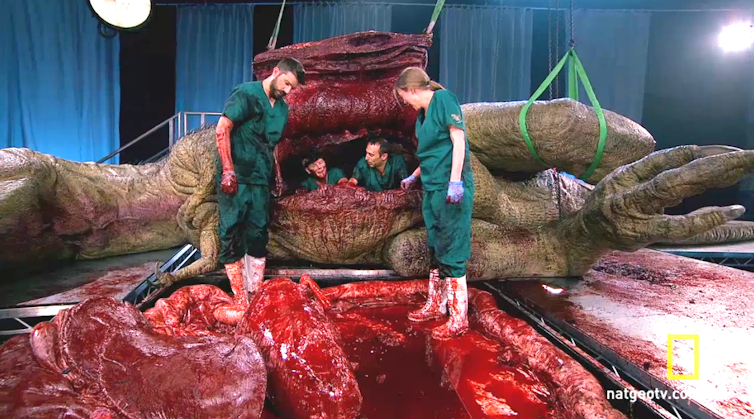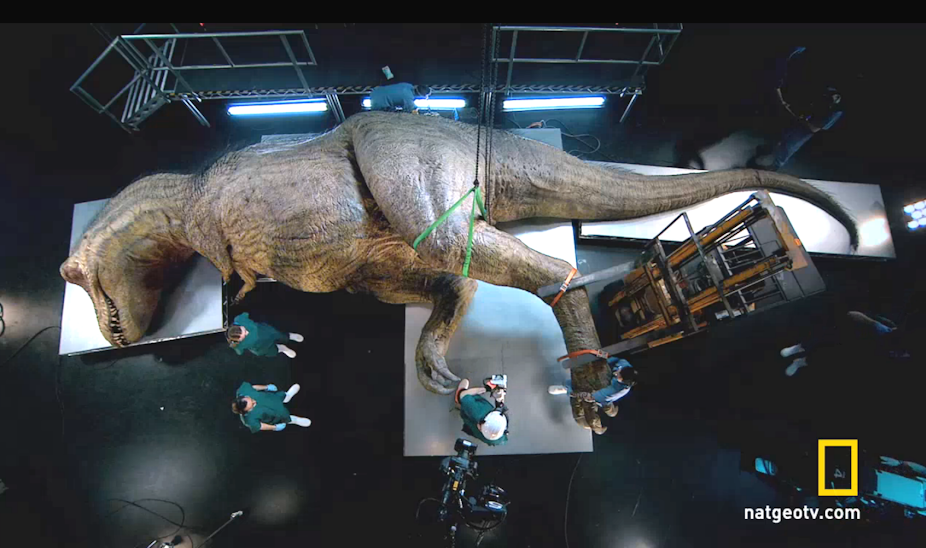I dissected a Tyrannosaurus rex in front of television cameras.
That may be the most surreal sentence I’ve ever written. So let me explain. I’m part of a team that built a life-sized model of Tyrannosaurus rex and then cut it up. The spectacle is a bloody, gory two-hour television special called T.rex Autopsy. The premise may seem absurd. But this is a whole new way of communicating science to the public, and it has been one of the highlights of my career.
I’m a paleontologist who has been studying dinosaurs for more than a decade. I’ve dug up T.rex fossils in the western United States, travelled the world studying tyrannosaur bones in museums, and described some of T.rex’s closest cousins. It’s a pretty cool job, but it comes with something of a peculiar annoyance. Sometimes I get strange people ringing me up with their pet theories on how dinosaurs evolved from space aliens, or emailing me long screeds about how dinosaurs never existed.
I got an email like that last August from a television producer in London. At first it seemed like a joke: they wanted to autopsy a T.rex corpse in front of the cameras. Just another ambitious but insane young producer, I thought, wanting to make his mark in a television landscape where shows on Bigfoot and mermaids are now standard fare on networks that used to be dedicated to science programming.
But I agreed to hear him out, and very quickly my opinion changed. They wanted to dissect a T.rex alright, but by building the most scientifically accurate model possible, then using the pageantry of an autopsy to reveal how this most famous of dinosaurs actually functioned as a living, breathing, feeding, moving, growing animal.
They needed a T.rex expert to consult on the build of the model. I signed up immediately, along with several of my esteemed colleagues, and was later asked to expand my role and appear on-screen as one of the dissectors. That was how I found myself in the famous Pinewood Studios near London last April, next to where they were filming the new Bond movie, chopping up a 43-foot T.rex with chainsaws, dripping with synthetic blood. Not a normal day at the office for an academic scientist who spends most of his time writing grants, advising students, and lecturing.
I’m incredibly proud of the end result. We’ll probably be criticised by some internet cynics who feel we’re trying to hoodwink the public into thinking this is a real tyrannosaur, or who disparage the whole idea of doing a dinosaur autopsy as too over-the-top. But that would be missing the point.
We took the utmost care to make sure our tyrannosaur was completely in line with what we know from fossils. Everything we couldn’t reconstruct from real fossils was informed speculation based on careful comparisons with living crocodiles, which are close cousins of dinosaurs, and birds, which are their descendants. And having four real scientists (a vet and three paleontologists) conducting the autopsy, without a script, made it even more authentic.
When I first walked into the autopsy room and saw the dinosaur, I was blown away. Yes I had consulted on the build, but the producers had deliberately prevented me from seeing the final model so I would be surprised. It was so realistic – pretty much how I think a real T.rex would have looked – but made of latex, silicone, plastic, corn syrup, and various other goodies. What the artists made in four-and-a-half months and 10,000+ man hours is surely the most accurate and life-like dinosaur of all time.
Inside rex
We go from head-to-tail on the dinosaur, cutting it up, talking about how each bit helps us understand T.rex as a living animal; what it ate, how fast it moved, what injuries it suffered, what its metabolism was like and how quickly it grew, how it reproduced.
So what exactly did we learn? If you thought dinosaurs were dim-witted, overgrown reptiles, think again. T.rex had a huge brain, its eyesight was keen, it had feathers and it grew really fast. It was essentially a huge fluffy bird from hell.
Some of my favourite moments were spent inside the belly of the beast, as we removed the super-sized internal organs. We don’t know much about dinosaur hearts and lungs and stomachs, because these soft parts don’t easily fossilise. But they can leave signatures on the bones, and we can use birds and crocodiles for plausible speculation. That’s how we designed the size, shape, and position of the guts in our model.
The organs were remarkably life-like, and I say this as somebody who has dissected a lot of animals. In particular, the suitcase-sized heart really looked and felt like it had just been cut from a real T.rex cadaver. The heart had four chambers inside, just like a bird, a sign of high metabolism and consistent with evidence from bones that T.rex was a dynamic, fast-growing animal.

The lungs had balloon-like extensions called air-sacs. These store air during the breathing cycle to make the lungs extra efficient, also just like birds. We know about these from the traces the air-sacs have left on T.rex bones. The stomach was also incredibly bird-like, with two chambers. This isn’t total speculation either: there is one spectacularly preserved tyrannosaur fossil with stomach contents that helped us in our design.
It’s easy to think of T.rex as a monster, a villain in movies, a terror in our nightmares. But it was a real living breathing animal, a great lost wonder of the world. If our programme gives people a sense of what this creature was really like, it will have been well worth the hard work.
T.rex Autopsy is on the National Geographic Channel.

